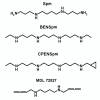Spermine oxidase (SMO) activity in breast tumor tissues and biochemical analysis of the anticancer spermine analogues BENSpm and CPENSpm
- PMID: 20946629
- PMCID: PMC3027604
- DOI: 10.1186/1471-2407-10-555
Spermine oxidase (SMO) activity in breast tumor tissues and biochemical analysis of the anticancer spermine analogues BENSpm and CPENSpm
Abstract
Background: Polyamine metabolism has a critical role in cell death and proliferation representing a potential target for intervention in breast cancer (BC). This study investigates the expression of spermine oxidase (SMO) and its prognostic significance in BC. Biochemical analysis of Spm analogues BENSpm and CPENSpm, utilized in anticancer therapy, was also carried out to test their property in silico and in vitro on the recombinant SMO enzyme.
Methods: BC tissue samples were analyzed for SMO transcript level and SMO activity. Student's t test was applied to evaluate the significance of the differences in value observed in T and NT samples. The structure modeling analysis of BENSpm and CPENSpm complexes formed with the SMO enzyme and their inhibitory activity, assayed by in vitro experiments, were examined.
Results: Both the expression level of SMO mRNA and SMO enzyme activity were significantly lower in BC samples compared to NT samples. The modeling of BENSpm and CPENSpm complexes formed with SMO and their inhibition properties showed that both were good inhibitors.
Conclusions: This study shows that underexpression of SMO is a negative marker in BC. The SMO induction is a remarkable chemotherapeutical target. The BENSpm and CPENSpm are efficient SMO inhibitors. The inhibition properties shown by these analogues could explain their poor positive outcomes in Phases I and II of clinical trials.
Figures




Similar articles
-
The role of the polyamine catabolic enzymes SSAT and SMO in the synergistic effects of standard chemotherapeutic agents with a polyamine analogue in human breast cancer cell lines.Cancer Chemother Pharmacol. 2010 May;65(6):1067-81. doi: 10.1007/s00280-009-1112-8. Epub 2009 Aug 30. Cancer Chemother Pharmacol. 2010. PMID: 19727732 Free PMC article.
-
Spermine oxidase SMO(PAOh1), Not N1-acetylpolyamine oxidase PAO, is the primary source of cytotoxic H2O2 in polyamine analogue-treated human breast cancer cell lines.J Biol Chem. 2005 Dec 2;280(48):39843-51. doi: 10.1074/jbc.M508177200. Epub 2005 Oct 5. J Biol Chem. 2005. PMID: 16207710
-
Induction of human spermine oxidase SMO(PAOh1) is regulated at the levels of new mRNA synthesis, mRNA stabilization and newly synthesized protein.Biochem J. 2005 Mar 15;386(Pt 3):543-7. doi: 10.1042/BJ20041084. Biochem J. 2005. PMID: 15496143 Free PMC article.
-
Spermine oxidase: ten years after.Amino Acids. 2012 Feb;42(2-3):441-50. doi: 10.1007/s00726-011-1014-z. Epub 2011 Aug 2. Amino Acids. 2012. PMID: 21809080 Review.
-
Spermine metabolism and anticancer therapy.Curr Cancer Drug Targets. 2009 Mar;9(2):118-30. doi: 10.2174/156800909787580935. Curr Cancer Drug Targets. 2009. PMID: 19275753 Review.
Cited by
-
Metabolomic Signatures of Scarff-Bloom-Richardson (SBR) Grade in Non-Metastatic Breast Cancer.Cancers (Basel). 2023 Mar 23;15(7):1941. doi: 10.3390/cancers15071941. Cancers (Basel). 2023. PMID: 37046602 Free PMC article.
-
Pathological Role of Unsaturated Aldehyde Acrolein in Diabetic Retinopathy.Front Immunol. 2020 Oct 22;11:589531. doi: 10.3389/fimmu.2020.589531. eCollection 2020. Front Immunol. 2020. PMID: 33193419 Free PMC article. Review.
-
Polyamine metabolism related gene index prediction of prognosis and immunotherapy response in breast cancer.Front Oncol. 2025 Jul 31;15:1613458. doi: 10.3389/fonc.2025.1613458. eCollection 2025. Front Oncol. 2025. PMID: 40823069 Free PMC article.
-
Regulation of Spermine Oxidase through Hypoxia-Inducible Factor-1α Signaling in Retinal Glial Cells under Hypoxic Conditions.Invest Ophthalmol Vis Sci. 2020 Jun 3;61(6):52. doi: 10.1167/iovs.61.6.52. Invest Ophthalmol Vis Sci. 2020. PMID: 32579679 Free PMC article.
-
Increased breast cancer cell toxicity by palladination of the polyamine analogue N (1),N (11)-bis(ethyl)norspermine.Amino Acids. 2014 Feb;46(2):339-52. doi: 10.1007/s00726-013-1621-y. Epub 2013 Dec 21. Amino Acids. 2014. PMID: 24363201 Free PMC article.
References
-
- Glikman PL, Manni A, Bartholomew M, Demers L. Polyamine involvement in basal and estradiol-stimulated insulin-like growth factor I secretion and action in breast cancer cells in culture. J Steroid Biochem Mol Biol. 1990;37:1–10. - PubMed
-
- Thomas T, Thomas TJ. Estradiol control of ornithine decarboxylase mRNA, enzyme activity, and polyamine levels in MCF-7 breast cancer cells: therapeutic implications. Breast Cancer Res Treat. 1994;29:189–201. - PubMed
-
- Casero RA Jr, Marton LJ. Targeting polyamine metabolism and function in cancer and other hyperproliferative diseases. Nat Rev Drug Discov. 2007;6:373–390. - PubMed
Publication types
MeSH terms
Substances
Grants and funding
LinkOut - more resources
Full Text Sources
Other Literature Sources
Medical
Research Materials
Miscellaneous

